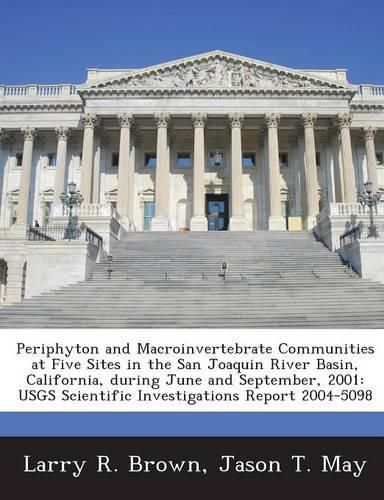Readings Newsletter
Become a Readings Member to make your shopping experience even easier.
Sign in or sign up for free!
You’re not far away from qualifying for FREE standard shipping within Australia
You’ve qualified for FREE standard shipping within Australia
The cart is loading…






The effects of agriculture, particularly from the use of pesticides, on aquatic ecosystems in the San Joaquin River Basin concern many aquatic resource managers, water quality managers, and water users. A total of five sites were sampled once in June 2001 and once in September 2001 to document the periphyton (attached algae) community, the benthic macroinvertebrate (insects and non-insects) community, and stream habitat conditions. The purposes of the study were to document existing conditions and, to the extent possible, relate the periphyton and macroinvertebrate community condition to environmental conditions. A total of 161 taxa of algae were collected during the study. Samples from the richest targeted habitat, woody debris, included 109 taxa. In both the June and September samples, greater than 95 percent of the taxa collected were diatoms. Cluster analysis and detrended correspondence analysis of sample data showed that Orestimba Creek had a very different periphyton community than the Merced and Tuolumne Rivers. Salt Slough and the San Joaquin River had community compositions that were intermediate between the two extremes. A total of 126 taxa of macroinvertebrates were collected during the study. Samples from woody debris included 59 taxa. The samples included a variety of both insect and non-insect taxa. Cluster analysis and detrended correspondence analysis of sample data showed that Orestimba Creek was very different from the Merced River and Tuolumne River, similar to the results for periphyton. Orestimba Creek was dominated by non-insects, while the Merced and Tuolumne Rivers were dominated by insects. Salt Slough was more similar to Orestimba Creek because of the abundance of non-insects. The San Joaquin River was more similar to the Merced and Tuolumne Rivers. There was no evidence of major differences between June and September samples for either the periphyton or macroinvertebrate communities. Specific conductance (a surrogate for salinity) and several habitat measures were associated with differences in the periphyton and macroinvertebrate communities at the five sites. Additional sampling at more sites over a longer period of time will likely be necessary before the effects of water quality and habitat conditions on aquatic communities are fully understood in the San Joaquin River Basin.
$9.00 standard shipping within Australia
FREE standard shipping within Australia for orders over $100.00
Express & International shipping calculated at checkout
The effects of agriculture, particularly from the use of pesticides, on aquatic ecosystems in the San Joaquin River Basin concern many aquatic resource managers, water quality managers, and water users. A total of five sites were sampled once in June 2001 and once in September 2001 to document the periphyton (attached algae) community, the benthic macroinvertebrate (insects and non-insects) community, and stream habitat conditions. The purposes of the study were to document existing conditions and, to the extent possible, relate the periphyton and macroinvertebrate community condition to environmental conditions. A total of 161 taxa of algae were collected during the study. Samples from the richest targeted habitat, woody debris, included 109 taxa. In both the June and September samples, greater than 95 percent of the taxa collected were diatoms. Cluster analysis and detrended correspondence analysis of sample data showed that Orestimba Creek had a very different periphyton community than the Merced and Tuolumne Rivers. Salt Slough and the San Joaquin River had community compositions that were intermediate between the two extremes. A total of 126 taxa of macroinvertebrates were collected during the study. Samples from woody debris included 59 taxa. The samples included a variety of both insect and non-insect taxa. Cluster analysis and detrended correspondence analysis of sample data showed that Orestimba Creek was very different from the Merced River and Tuolumne River, similar to the results for periphyton. Orestimba Creek was dominated by non-insects, while the Merced and Tuolumne Rivers were dominated by insects. Salt Slough was more similar to Orestimba Creek because of the abundance of non-insects. The San Joaquin River was more similar to the Merced and Tuolumne Rivers. There was no evidence of major differences between June and September samples for either the periphyton or macroinvertebrate communities. Specific conductance (a surrogate for salinity) and several habitat measures were associated with differences in the periphyton and macroinvertebrate communities at the five sites. Additional sampling at more sites over a longer period of time will likely be necessary before the effects of water quality and habitat conditions on aquatic communities are fully understood in the San Joaquin River Basin.